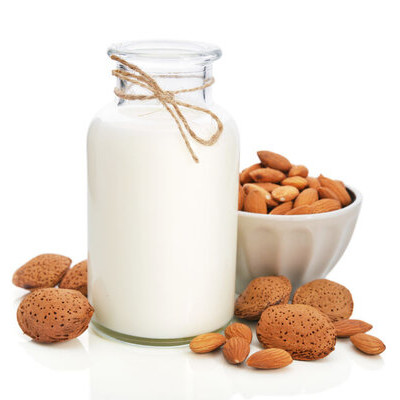
Almond Milk
Also known as Almond Nut Drink
What is Almond Milk?
Almond milk is a plant-based liquid commonly used to substitute animal-based milk. It is made from almond nut seed through a mechanical process. Almond milk is gluten- and lactose-free, and has a characteristic nutty flavor and mildly sweet taste. It is used in:1,2
- Baking
- Confections
- Granola bars
- Breakfast cereals
- Coffee based drinks
Origin of almond milk
This plant-based milk has been known since the 13th century, according to ancient references in Baghdadi and Egyptian cookbooks. Recently, its popularity increased significantly due to health, environmental and ethical consumer concerns. Currently, it is a very popular plant-based milk substitute in the United States and Europe.3
Function
Similar to cow’s milk, this milk provides several benefits to bakery systems: 1,2,3
- Moisture: for dissolution of salt and sugars, and aid in gluten development.
- Color: due to sugar and proteins participation in Maillard browning reactions.
- Flavor: milky nutty flavor.
- Foaming: by creating stable and long-lasting foams.
Nutrition
Typical nutritional value of a commercial almond milk per 100 mL:1
| Component | Grams |
|---|---|
| Carbohydrate | 4.30 – 4.70 |
| Fat | 3.20 – 3.60 |
| Protein | 1.90 – 2.50 |
| Fiber | 1.15 – 1.35 |
This milk provides 55 – 55.90 kcal per 100 mL. It is naturally gluten-free. However, it may cause common nut-allergys. Other benefits include its antioxidant and prebiotic properties, low-fat and low caloric value.1
Commercial production
The following processes are used to produce almond milk industrially :1,3
Wet processing
- Conditioning: cleaned almond nuts are washed and soaked in water with a small amount of salt for around 12 hours followed by rinsing and draining.
- Grinding: drained nuts are ground to a smooth paste with hammer mills.
- Centrifugation: fibrous components are removed with a centrifugal decanter to improve appearance and adjust viscosity of the final product.
- Blending and fortification with vitamins, calcium, and other minerals.
- Homogenization
- Packaging
Dry processing
- Washing and drying of harvested almond nuts.
- Grinding: into a fine powder with hammer mills.
- Formulation: addition of water and fortification with vitamins and minerals.
- Packaging
Application
Almond milk is commonly used to substitute cow’s milk in baked products such as muffins, cookies, cakes and breads.1 Custards are not good candidates for almond milk substitution due to lack of structural support for egg coagulation.2
Typically, cow milk can be substituted 1:1 with almond milk, producing similar results in most baked products.1,3
Some common characteristics of almond milk baked goods are:4
- Shorter cooking times due to higher water content than cow’ milk.
- Reduced sweetness due to the absence of naturally occurring sugars.
- Paler color in sugar cookies and quick bread due to the low protein content necessary for Maillard browning reaction.
- Fine, moderately tender crumb.
- No off-flavors are generated during baking.
Some considerations when using almond milk in baked goods:
- May need higher levels of thickening agents.
- Use medium temperature and constantly stir when cooking almond milk on the stove top.
- Avoid adding acidic ingredients to almond milk, because it may curdle.
Regulations
Almond milk is considered safe by the FDA when consumed by people without a nut-based allergy. It’s still debatable whether plant-based dairy alternatives can use terms such as: milk, cheese or yogurt due to the difference in nutritional value between these products.4
In the EU, almond milk is considered safe when consumed by people without a nut-based allergy. A similar debate is going on in Europe whether plant-based products should use terms reserved for dairy according to the EU Commission No 1308/2013.5
References
- Paul, A. A; Kumar, S; Kumar, V and Sharma, R . “Milk Analog: Plant based alternatives to conventional milk, production, potential and health concerns.” Critical Reviews in Food Science and Nutrition (2019): 1-19.
- Figoni, P. How Baking Works: Exploring The Fundamentals Of Baking Science. 2nd ed., John Wiley & Sons, Inc., 2008.
- McHugh, T. “How plant-based milks are processed.” Food Technology 72 (2018): 63-64.
- Crosby, Guy. Cook’s Science: How To Unlock Flavor In 50 Of Our Favorite Ingredients. 1st ed., Random House Inc, 2016.
- Goldman, Eric. “Use of the Names of Dairy Foods in the Labeling of Plant-Based Products.” 2018.
- European Commission (EC). Commission Regulation (Eu) No 1308/2013 Of The European Parliament And Of The Council Of 17 December 2013 Establishing A Common Organisation Of The Markets In Agricultural Products And Repealing Council Regulations (Eec) No 922/72, (Eec) No 234/79, (Ec) No 1037/2001 And (Ec) No 1234/2007 . Official Journal Of European Communities, 12 December 2013.

